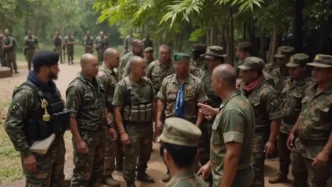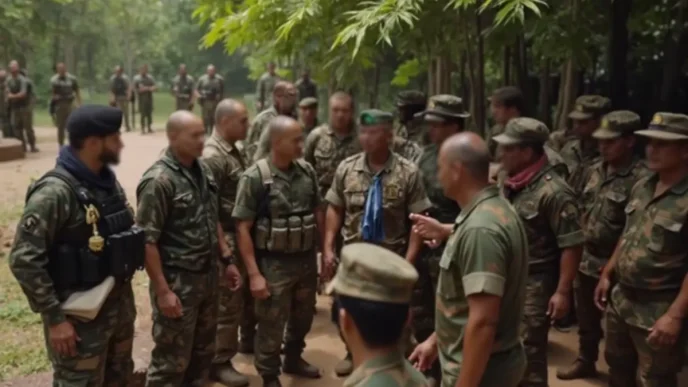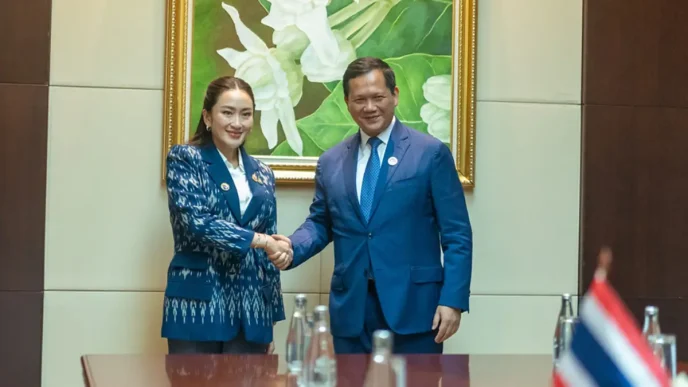In a festive gesture marking the Khmer New Year, Cambodia has temporarily opened its tallest bridge to the public, offering a new vantage point for holiday travelers in Pursat province. The 90-meter-high structure, spanning the Russey Chrum stream in Chhay Louk village of Veal Veng district, welcomed family vehicles and motorcycles starting at 6am on April 11. This limited opening, which runs until April 17, coincides with one of the country’s most significant cultural celebrations, drawing attention to both infrastructure progress and public safety concerns.
A Milestone in National Road 10 Development
The bridge, the 28th of 32 along National Road 10, stretches 538 meters in length and 10 meters in width, connecting communities across the Russey Chrum stream in O’Som commune. With construction 98% complete, the temporary opening allows locals and visitors to experience the structure during the Khmer New Year, a time when families reunite and travel peaks across the Kingdom. The project, part of a broader 66-month initiative launched in December 2019, underscores Cambodia’s push to modernize its transportation network, with full completion expected by June 2025.
Phorn Rim, spokesperson for the Ministry of Public Works and Transport, emphasized the restrictions in place to ensure safety during this period. “This temporary opening is for family vehicles and motorcycles only, from 6am to 6pm. To ensure public safety, vehicles are strictly prohibited from stopping on the bridge. Meanwhile, trucks and other heavy vehicles must continue using the usual detour routes” said Phorn Rim. The daytime-only access reflects ongoing concerns about incomplete signage and road markings, critical elements for safe navigation, especially after dark.
Final Touches and Safety Precautions
On April 8, Sun Chanthol, first vice-president of the Council for the Development of Cambodia (CDC) and Minister of Public Works and Transport, alongside Minister Peng Ponea, oversaw the final concrete connection at the bridge’s approach to facilitate this temporary access. During the ceremony, Chanthol elaborated on the decision to limit operating hours. “This bridge is open from 6am to 6pm. Why not at night? Because the proper signage and road markings are not yet in place. Without those, we’re concerned for the safety of citizens. Once they are ready, we’ll open the road to the public in early May” he said.
Following the Khmer New Year period, the bridge will close again for final touches, including the installation of signage and markings. Authorities have also responded to public enthusiasm by expanding viewing platforms on either side of the bridge by an additional 2.5 meters, at the request of the government to the Chinese construction company overseeing the project. These platforms offer a scenic view of the surrounding landscape, a draw for holidaymakers eager to capture commemorative photos. However, Chanthol urged the public to refrain from parking on the bridge itself to avoid traffic congestion, advising drivers to park outside the bridge area instead.
A Call for Responsible Celebration
Beyond the logistical details, officials used the opening as an opportunity to remind citizens of the importance of road safety, particularly during festive seasons like Khmer New Year. Chanthol called on the public to respect Cambodia’s traffic laws to prevent accidents that could mar the holiday spirit. His plea to avoid turning “a joyful day into a day of sorrow” resonates in a country where traffic incidents often spike during major holidays due to increased travel and celebratory activities.
The Khmer New Year, or Choul Chnam Thmey, typically sees Cambodians returning to their hometowns, visiting pagodas, and participating in traditional games and rituals. The opening of the bridge, even temporarily, adds a modern dimension to these age-old customs, providing a symbolic link between Cambodia’s cultural heritage and its aspirations for development. Yet, the emphasis on safety reflects a broader awareness of the challenges that accompany rapid infrastructure growth in a nation still grappling with uneven road conditions and enforcement of traffic regulations.
Broader Implications for Cambodia’s Infrastructure
The National Road 10 project, which began with a groundbreaking ceremony in March 2020, is a key component of Cambodia’s efforts to enhance connectivity between rural and urban areas. Improved roads and bridges are expected to boost local economies by facilitating the transport of goods and people, particularly in provinces like Pursat, which lie along critical trade and travel corridors. The government’s collaboration with international partners, including Chinese construction firms, highlights the scale of investment being poured into such initiatives, though it also raises questions about long-term sustainability and debt obligations—issues that continue to spark debate among policymakers and citizens alike.
For now, the focus remains on the immediate impact of the bridge’s opening. Residents of Chhay Louk village and surrounding areas have expressed excitement about the structure, with many planning to cross it during the holiday period. The viewing platforms, in particular, have become a point of interest, offering a rare elevated perspective of Pursat’s natural beauty. Social media posts on platforms like X reflect a mix of pride and curiosity, with users sharing images of the bridge and commenting on its significance as a symbol of progress.
Looking Ahead
As Cambodia balances celebration with caution, the temporary opening of its tallest bridge serves as a preview of what lies ahead once the National Road 10 project is fully realized. For the thousands of families traversing Pursat province this Khmer New Year, the structure offers not just a practical crossing but a moment of shared achievement. Yet, with final completion still weeks away, the government’s message is clear: safety must come first, even amidst the joy of the season.














